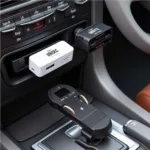The OBD2 federal mandate, implemented in 1996, revolutionized the automotive industry. This regulation required all vehicles sold in the United States to be equipped with an OBD2 port and adhere to standardized diagnostic protocols. This means that instead of relying on various manufacturer-specific systems, mechanics and car owners could use a single device – the OBD2 scanner – to access valuable information about a vehicle’s emissions system and overall health.
Understanding the Impact of the OBD2 Federal Mandate
Prior to 1996, diagnosing car problems often felt like navigating a maze of proprietary systems. Each manufacturer had its own methods, making it difficult and expensive for mechanics to service different makes and models. The OBD2 mandate simplified this process, making it easier to identify and repair issues, ultimately leading to cleaner air and safer vehicles on the road.
How the OBD2 Mandate Benefits Car Owners
The OBD2 mandate wasn’t just beneficial for mechanics; it empowered car owners as well. Here’s how:
-
Early Problem Detection: The OBD2 system constantly monitors your car’s engine and emissions systems. If a problem arises, it triggers the check engine light and stores a corresponding diagnostic trouble code (DTC) in the car’s computer. This early detection allows you to address issues before they escalate into costly repairs.
-
Simplified Diagnostics: No longer do you need to rely solely on a mechanic’s interpretation of vague symptoms. With an OBD2 scanner, you can read the DTCs yourself, gaining a clearer understanding of your car’s health.
-
Increased Transparency: Armed with the knowledge from the OBD2 scanner, you can approach a mechanic with more confidence, ensuring fair pricing and avoiding unnecessary repairs.
Demystifying Diagnostic Trouble Codes (DTCs)
DTCs are alphanumeric codes that pinpoint specific areas within your car’s systems where malfunctions are detected. These codes follow a standardized format, making them universally understandable. For instance:
- P0301: This code indicates a misfire detected in cylinder 1.
- P0401: This code signals an issue with the Exhaust Gas Recirculation (EGR) system’s flow.
While DTCs offer valuable clues, it’s crucial to remember that they don’t always present a complete picture. They indicate the area of concern, but further investigation is often needed to identify the root cause.
Choosing the Right OBD2 Scanner: A Buyer’s Guide
The market is flooded with OBD2 scanners, ranging from basic code readers to professional-grade diagnostic tools. Understanding your needs and budget is key to making the right choice.
Basic Code Readers: These affordable devices read and clear basic DTCs, making them suitable for DIY enthusiasts who want to understand why their check engine light is on.
Advanced Scanners: These offer more features, such as live data streaming, allowing you to monitor various engine parameters in real-time. This is beneficial for those who enjoy tinkering with their cars or want more in-depth diagnostics.
Professional Scanners: Mechanics and serious DIYers benefit from professional-grade scanners. These provide comprehensive diagnostic capabilities, including advanced functions like bi-directional control (allowing you to activate certain car components) and access to manufacturer-specific codes.
Beyond Emissions: The Expanding Role of OBD2
While the OBD2 mandate initially focused on emissions control, its scope has expanded over the years. Modern OBD2 systems provide access to a wealth of data beyond just emissions, including:
-
Engine Performance: Monitor RPM, speed, temperature, and other vital engine parameters.
-
Transmission Data: Access information about gear ratios, shift patterns, and transmission fluid temperature.
-
Safety Systems: Some vehicles use the OBD2 system to monitor airbags, ABS, and other safety-related components.
“The beauty of the OBD2 standard is its adaptability,” says automotive engineer Sarah Chen. “What began as an emissions control measure has evolved into a gateway for accessing a vehicle’s overall health, paving the way for more sophisticated diagnostics and even predictive maintenance.”
The Future of OBD2: Connected Cars and Beyond
As vehicles become increasingly connected, the role of the OBD2 system is poised to evolve even further. Telematics, which uses the OBD2 port to transmit vehicle data, is already being used for insurance purposes, fleet management, and even remote diagnostics.
The OBD2 federal mandate, once solely focused on cleaner air, has had a ripple effect on the automotive landscape. It has empowered car owners, streamlined diagnostics, and paved the way for the connected car revolution. Understanding the OBD2 system is no longer just a matter of convenience but an essential aspect of car ownership in the digital age.
FAQ: Common Questions about the OBD2 Federal Mandate
1. Do all cars have an OBD2 port?
All gasoline-powered vehicles sold in the United States from 1996 onwards are required to have an OBD2 port. Diesel vehicles were mandated to have OBD2 ports starting in 1997.
2. Can I clear my own check engine light?
Yes, you can use an OBD2 scanner to clear the check engine light. However, it’s essential to address the underlying issue that triggered the light in the first place. Simply clearing the code without fixing the problem is not a solution.
3. Is it legal to drive with the check engine light on?
While it’s not illegal to drive a short distance with the check engine light on, it’s not advisable. The light indicates a potential problem that could affect your car’s performance, emissions, or even safety.
4. Do I need a mechanic to use an OBD2 scanner?
Not necessarily. Basic OBD2 scanners are user-friendly and can be easily used by car owners. However, more advanced scanners might require some technical knowledge to interpret the data correctly.
5. Can an OBD2 scanner tell me everything that’s wrong with my car?
While an OBD2 scanner provides valuable insights into your car’s health, it doesn’t cover everything. It primarily focuses on the engine and emissions systems. Other issues like body damage or suspension problems might not be detected.
Need further assistance with OBD2 scanners or have more questions? Don’t hesitate to reach out to our team via WhatsApp: +1(641)206-8880 or Email: [email protected]. Our dedicated customer support team is available 24/7 to assist you.


